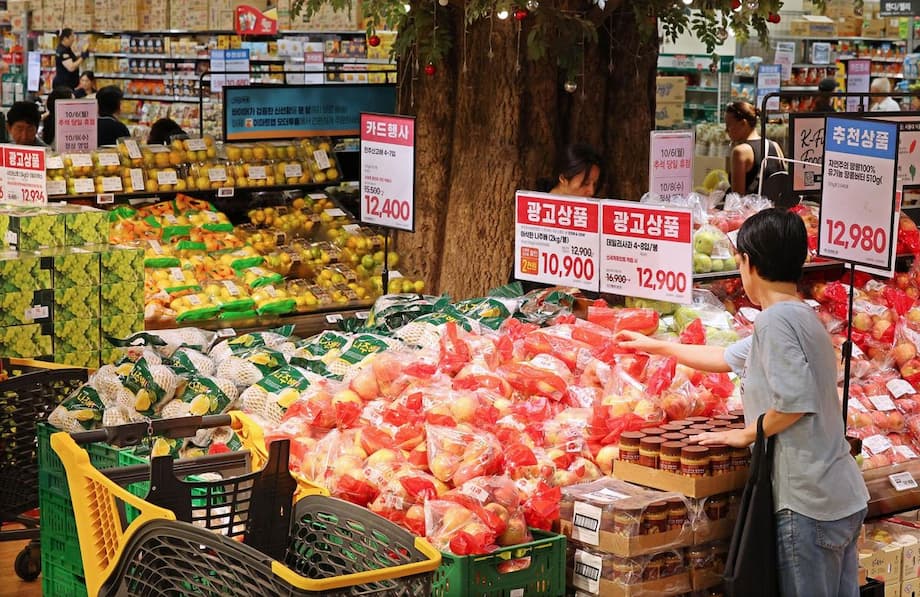Why do Chuseok prices jump every year?
Chuseok concentrates food buying into a short window when millions of families shop for gatherings, memorial rites and generous meals. Households stock up on meat, fruit, vegetables, rice, cooking oil and confectionery, and many also purchase gift sets. Wholesalers and retailers must meet this surge in days, not months. When many buyers chase the same goods at the same time, prices climb. Farmers and distributors cannot instantly expand output or delivery capacity. The result is a familiar late September or early October price bump that shows up across markets.
- Why do Chuseok prices jump every year?
- What the government is doing this year
- Will more supply actually lower prices
- The distribution cost problem the plan tries to fix
- Agriculture outlook and risks ahead of the holiday
- How shoppers can make the most of holiday programs
- The wider economic picture
- Key Points
Seasonal demand meets tight supply
Fresh produce follows a seasonal calendar. Apples and pears ripen in late summer, and staples like napa cabbage and radish are harvested on schedules that depend on planting choices and weather. Cold storage helps but capacity is finite. Imports are constrained by sanitary rules and shipping schedules. If harvests are smaller or logistics slow down ahead of the holiday, supply cannot scale quickly. With demand rising sharply and supply slow to adjust, market prices jump.
Gift sets and premium items push averages higher
Gift giving is part of the season, and retailers curate sets built around premium fruits, seafood and hanwoo, the prized domestic beef. Popular boxes also include staples like canned meat or personal care items such as shampoo. These baskets soak up supply and they command higher margins. When many households choose premium items, the price averages reported in consumer price indexes can climb even if basic staples are steadier.
What the government is doing this year
This year the economic team is moving early and at scale. Authorities will release a record 172,000 tons of key food items before and during the shopping peak. The plan raises pre holiday supply to around 1.6 times the usual volume for major goods. The budget for discounts totals about 90 billion won (64.5 million dollars). Shoppers will see up to 50 percent reductions on popular gift sets and deals on daily staples such as eggs, rice, fruit, beef and pork. The program was finalized at a ministerial meeting led by the finance minister, and the first vice finance minister reviewed execution details ahead of the holiday.
To make discounted goods easier to find, the government and local partners will operate roughly 2,700 direct to consumer markets nationwide. Major supermarkets and traditional markets will participate. Discount support will cover a list of holiday items that tend to swing in price, and will be time limited to spread purchasing across the holiday rush rather than concentrate it on a single weekend.
On the supply side, premium beef supply will be nearly double compared with a typical Chuseok. Pork distribution will be about 30 percent above the usual volume. Egg shipments and discount support will also increase. For rice, officials plan to release 30,000 tons from government stocks to steady prices. The goal is to lift availability where shortages usually appear, then let retailers pass those savings through to shoppers at the counter.
Will more supply actually lower prices
Injecting reserves at the right time can soften pricing pressure because the market clears at the point where supply meets demand. If buyers suddenly want more beef and apples during a single week, the extra stock adds to the quantities offered at wholesale auctions and retail depots. When the supply curve shifts outward, the clearing price falls. Discounts amplify the effect by moving some demand to lower priced items and by encouraging retailers to promote less costly bundles.
The design of the program matters. Targeting specific goods that are prone to spikes, such as hanwoo cuts or high grade fruit, can help because these items carry a big weight in holiday budgets. Direct to consumer markets reduce the number of intermediaries, so less of the subsidy gets absorbed by distribution fees. Oversight also matters. If retailers claim a subsidy without lowering tags, the benefit would sit in margins instead of easing bills. Public monitoring during the holiday window increases the chance that the savings reach households.
The distribution cost problem the plan tries to fix
Short term interventions are only part of the story. The government is also aiming at the structure of the farm to table pipeline. The share of distribution costs in final consumer prices reached about 49.2 percent in 2023. A decade earlier it was near 45 percent. This spread, which measures the gap between what consumers pay and what producers receive, is often blamed for high and unstable prices of fresh food. Cutting that share would help both farmers and shoppers.
Officials have set a goal to reduce agricultural distribution costs by 10 percent by 2030. A centerpiece is an expansion of online wholesale markets. These digital exchanges handle roughly 6 percent of wholesale transactions today. The plan is to lift that share to 50 percent by 2030. More digital trading can increase competition among distributors, streamline auctions, and improve transparency on fees. Coupled with improvements in cold chain logistics and standardized packaging, the reforms are meant to keep food prices steadier even outside holiday seasons.
Agriculture outlook and risks ahead of the holiday
Crop conditions appear manageable heading into this year’s holiday. Because the date falls later than usual, growers report better alignment between harvest windows and demand. Apple and pear output is expected to meet seasonal needs despite earlier cold snaps and wildfires. Vegetable supplies such as cabbage and radish look stable after farmers adjusted planting schedules. Agencies are still tracking weather driven volatility, since a typhoon or a heat wave close to the holiday can move prices in a few days.
Livestock remains a pressure point. Feed and import costs have kept cattle and pork prices firm. To mitigate that pressure, the state will expand domestic supply and support discounts for consumers. Rice is another focus. Releasing 30,000 tons from stocks gives mills and retailers flexibility if private inventories turn out to be tight. Officials say these steps are precautionary, since keeping staple prices stable can protect the effect of any holiday consumption boost.
How shoppers can make the most of holiday programs
Deals will vary by retailer and location, but there are practical ways to capture the benefits on offer without sacrificing quality. Households that plan early and compare options often see the largest savings.
- Look for the public direct to consumer markets operating in your area. These pop up in schools, community centers, and public plazas during the season.
- Check multiple retailers. Traditional markets may post strong fruit deals, while large grocers lean into gift sets and meat bundles.
- Use the available discount coupons or card promotions tied to the program. These are time limited and can stack with in store sales.
- Consider alternative cuts when buying hanwoo or pork. Less popular cuts often deliver the same quality at a lower price.
- Buy non perishables first, then add fresh items closer to the family gathering to reduce waste.
- Inspect labeling for origin and grade. This helps compare like for like across stores.
The wider economic picture
Headline inflation has been within the Bank of Korea’s 2 percent target, yet some holiday staples have tracked higher than that pace in recent months. That is why the price unit of the government is putting more weight on seasonal programs that lift supply and temporarily subsidize demand. Policymakers also want to support household consumption, which has been recovering. Retail sales in midsummer recorded the largest increase in more than two years, a signal that sentiment is improving.
Holiday logistics show how sensitive the system can be to stress. A recent outage of the national rail ticketing app disrupted travel bookings for several hours when many people were trying to reserve seats for journeys to hometowns. Congestion on the roads, tight delivery windows and labor shortages in distribution can have similar effects on food supply. Coordination among economic, agriculture and transport agencies can prevent small disruptions from turning into price spikes when families are preparing for the holiday.
Key Points
- Authorities will release a record 172,000 tons of food reserves to steady prices during the Chuseok shopping peak.
- Discount programs worth about 90 billion won will cut some holiday gift sets and staples by up to 50 percent.
- Pre holiday supply for major goods will be around 1.6 times the usual volume to meet concentrated demand.
- About 2,700 direct to consumer markets nationwide will expand access to lower priced products.
- Premium beef supply will be nearly double and pork about 30 percent above typical holiday levels.
- Rice prices will be supported by a 30,000 ton release from government stocks.
- The state aims to cut agricultural distribution costs by 10 percent by 2030 and expand online wholesale markets to 50 percent of transactions.
- Crop conditions look stable for apples, pears, cabbage and radish, though weather remains a risk, while livestock prices stay firm on higher import costs.
- Headline inflation sits near the central bank’s target, yet seasonal spikes in holiday staples justify focused interventions.




